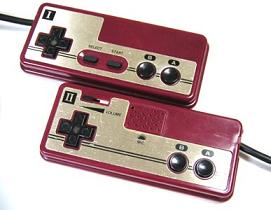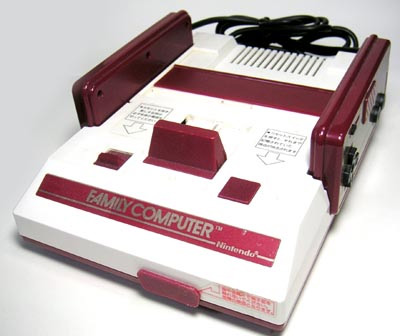Nintendo Co., Ltd., originally a playing card company, began making TV gaming systems in the 1970s, updating Pong and having mild success with its systems; however, it was the Famicom that set Nintendo's profits on fire and propelled Nintendo to the top of the video game empire.

Nintendo released the brilliant white and red Famicom in Japan in 1983, after the failure of Atari and on the dawn of a new era of gaming. Up until the 1980s, children were playing classics such as Donkey Kong in the arcades and on Atari consoles, but simply wanted something new and more diverse. So, after some re-tooling of their arcade games, Nintendo sent forth to living rooms around the world the Famicom, in Japan, and its brother console, the Nintendo Entertainment System (NES), released to the rest of the developed world. Famicom is, of course, short for Family Computer.
The Famicom comes with two controllers, fixed on both sides of the console by short black cords, which forced young gamers to sit closer to their TV screens when playing. The second of the two controllers was given a microphone function, which could be used in some games, including karaoke, or could be used to irritate your friends by talking through the TV speakers.
The Famicom had a large red knob used to slide the games out of the pins slot. It had the standard On/Off button and a reset button. A port at the front of the console allowed for accessories, such as controllers, a 3D system and handheld microphone to be connected. Accessories were introduced throughout the Famicom decade, enhancing gameplay like never before. The Famicom was a hot item from the day it was released, though the first release of the Famicom, known as the square-buttoned Famicom, had glitches that irked early gamers.
The games came in simple plastic cartridges that would you insert into the Famicom, similar to the top-loading NES with which the rest of the world is familiar. The cartridges came in various different colors with often great label art. The cartridges varied in size and shape, but never were made as large as an NES cartridge.

Super Mario USA is one of the many colorful Famicom carts.
Like with the NES, Famicom cartridges became a problem. Some games would freeze up during gameplay or not play at all due to dust and grime that got in between the contacts on the cartridge and the console. Though cleaning was encouraged, the cartridges were very small and often difficult to open.
Because the Famicom never came with a lock-out chip, like versions of the NES that kept unlicensed and pirated cartridges from being played, pirated cartridges abounded in Asia. Just about everywhere you turn today you can get pirates of 8-bit games and sometimes even 16-bit games (reduced to 8-bit quality). Strangely enough, even though gaming had moved beyond the 8-bit era, some shady companies continued to make pirates into the turn of the century.

A pirate of one of the Nekketsu series games.
The Famicom originally retailed for 14,800yen (about $120 in today's dollars) and sold nearly 19.4 million units. Nintendo stopped producing the Famicom in September 2003 because secondary companies were no longer manufacturing the parts Nintendo needed.


